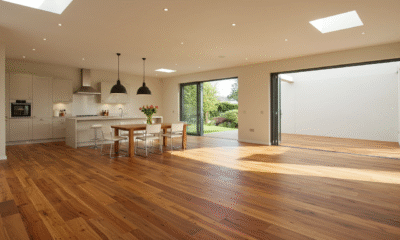In today’s day and age of continuous technological advancements and the ongoing threat of climate change, why not combine the two by creating your very own smart home?
After all, ‘smart’ artificial intelligence (AI)-based technology has come on leaps and bounds in recent years, with more and more homes throughout the UK now being run by a digital assistant of some variety.
Whether it be Alexa, Google Assistant, Siri or Cortana, these smart devices are designed to lower your energy bills while making your life easier at the same time.
From smart bulbs that you can turn on and off with only your voice to smart thermostats that you can control while away from home, it can be a lot easier than you might think to create a home that is as smart as it is sustainable.
So, if you’re in the market to make a few home upgrades, you’ve come to the right place. Join us as we take a detailed look at how to set up a sustainable smart home, highlighting some of the best devices we think you should invest in.
Choose only one AI assistant.
The first thing you will need to bear in mind when designing a smart home is the artificial intelligence-based (AI) virtual assistant you choose to use. Ideally, they will need to be the same, although specific assistants – like Alexa and Google Assistant – do occasionally have some overlap between smart devices.
Generally speaking, however, you won’t be able to control an Amazon Echo smart speaker using Siri or an Apple HomeKit smart hub with Alexa. Therefore, it’s essential to decide which virtual assistant you would like to use around your home and only ever purchase the smart speaker devices affiliated with that AI.
In doing so, this will help ensure your smart home stays a lot more seamlessly interconnected while avoiding any unnecessary expenditure.
Replace your existing thermostat.
Investing in a smart thermostat could not only revolutionize your home but could also save you a ton of money in terms of energy costs at the same time as well.
Whether it be the Google Nest Learning Thermostat, the Hive Active Heating Thermostat or the Tado Smart Thermostat, there are many options available. Each works in a similar way to one another.
Operating in the same way as a traditional thermostat, smart thermostats allow you to control the heating schedule and your home’s temperature from your smartphone.
They also seamlessly sync up with your smart hub, allowing you to control the temperature using your voice and setting routines to give you total freedom of control – even when you’re away from home.
However, unless you’ve had the sufficient electrical training required, installing one will require the expertise of an engineer which will come at an additional cost.
Invest in smart plugs.
Smart plugs offer a quick and easy way to turn more or less any of your electrical appliances into a ‘smart’ device.
From fans to dehumidifiers to TVs, whichever device you choose, using a smart plug will allow you to control their function from either your smartphone or by using your smart hub. This, in turn, will again allow you to cut down on your energy bills since you will only ever be spending out on the energy you need to use.
Rather than leaving your TV or microwave on standby all day and night, for instance, controlling it using a smart plug will allow your home to become a lot more sustainable as a result.
Go all-in with smart devices.
Let’s not beat around the bush here, investing in a smart home can be a fairly costly venture.
Smart lighting from companies like Philips Hue, for instance, can quickly mount up when you consider how many lights you have around the home. However, the energy savings these can offer over the long run could promptly outweigh the up-front cost, so it’s really up to you to weigh up which types of smart devices are worth spending your money on.
From smart ovens to smart fridges to smart blinds, there are currently many ways to make your home as interconnected as possible, utilizing AI assistants and smartphone apps to continuously learn how to improve the efficiency of your home.
However, one of the best devices to consider from a security point of view is a video doorbell. Available from companies like Ring, Eufy and Google Nest, these doorbells allow you to keep tabs on your home while you’re away, making you aware of any potentially suspicious activity.
Time to make the change.
Generally speaking, basic smart home setups in today’s market will feature smart lighting, a smart thermostat, a smart TV, a smart video doorbell and a smart hub.
If and how you decide to add to this basic framework is entirely up to you – from purchasing a smart fridge to setting up a mesh Wi-Fi network system to investing in a smart toilet seat to creating a smart surround sound system, the choice of smart technology is endless.
When embracing sustainability, the key thing to remember is to only ever invest in smart tech that cuts your energy bills down, improves your home’s carbon footprint, and makes your life easier.


 Environment10 months ago
Environment10 months agoAre Polymer Banknotes: an Eco-Friendly Trend or a Groundswell?

 Environment12 months ago
Environment12 months agoEco-Friendly Home Improvements: Top 7 Upgrades for 2025

 Features9 months ago
Features9 months agoEco-Friendly Cryptocurrencies: Sustainable Investment Choices

 Features10 months ago
Features10 months agoEco-Friendly Crypto Traders Must Find the Right Exchange




























